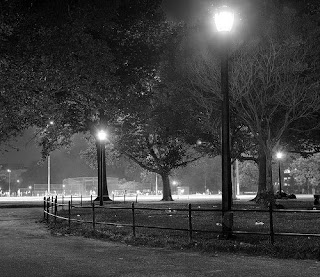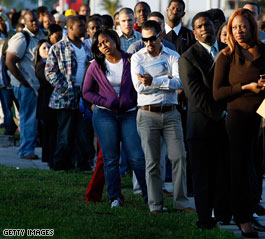Based on what I've observed since living here, my plethora of New York City-based films, and what I know about music in New York, the center of activity has been constantly moving around the city since the 1950's. Rent is cheap in certain areas, poor aspiring musicians move to that area, and it becomes a great cultural center for music and art. So WHERE does this happen, how long does it last, and why?
Times Square

I guess the best place to start is Times Square. The commercial tourist center of the world, Times Square is probably the last place you'd go to see young artists these days. It's packed with retail stores and expensive restaurants, and while there are many shows around the area, they are usually very established people charging outrageous prices. However, it wasn't always like this.

In the 1920's, Charlie Chaplin and Fred Astaire were tied to Times Square and referred to it as The Tenderloin, the most desirable place to live in Manhattan. After the depression, it was a haven for gambling and strip clubs. It was considered dangerous in the 50's, and it wasn't until Rudy Guiliani started his mass cleanup in the 1990's did the area become commercialized.
Carnegie Hall, on 57th St, was a main attraction for people like Miles Davis, John Coltrane, and Thelonious Monk. Midtown (between 14th and 59th) is still the center of New York industry and activity, but in the 1950's, there were many more seedy bars and small jazz clubs.
Greenwich Village

If you go to Greenwich Village today, home of NYU, there is still a great amount of music and cultural activity. Washington Square is always alive with street musicians. The West Village has great food and small music clubs, and there is a good deal of young aspiring students. However, it's kinda missing something nowadays. The Village at night reminds me of Beaver Ave in State College, just a lot of young kids drinking and walking the streets. Rent is expensive, though, and it kind of seems like a museum that wants to reflect what it once was.
I had this same feeling the last time I visited San Francisco. North Beach, the home of Jack Kerouac, Allen Ginsburg, and William Burroughs, was the West Coast equivalent of Greenwich Village. In the late 50's and 1960's, they were the centers for Beatnik activity. Bob Dylan, the Mamas and the Papas, Peter Paul and Mary, Jimi Hendrix, Simon and Garfunkel, Jackson Browne, The Velvet Underground, Joan Baez, and many others got their start here. The Weather Underground was also based in The Village. If you visit The Village today, it is a great place for dinner. Washington Square is bustling on a nice day, and there is music everywhere. People are generally a little older though, and it seems like the Bohemian days of old are long gone.
The Lower East Side

Initially a primarily immigrant neighborhood, the gentrification of the Lower East Side happened when rent in The Village started getting very high. These days, the LES is still a pretty hip place. The rent is low, for Manhattan, and there are moderately priced bars on Ludlow St and Rivington.

The Mars Bar (2nd Ave & 1st St) is one of my favorite bars in Manhattan. The Lit Lounge has a huge basement with DJs all the time. The Cake Shop is a great bar/coffee shop with bands every night of the week.
The LES has a lot of art galleries, and is probably the easiest area to get a gig for a new band in New York. I've played in the Lower East Side several times with the Bullet Parade, and friends of mine continue to play there all the time. It's probably one of the cheapest areas to live in Manhattan, but gentrification peaked in the late 1980's, and people started moving across the bridge...
Williamsburg, Brooklyn

Across the Williamsburg Bridge from the LES sits Williamsburg, the hippest place on the map. Since 2000, gentrification of Brooklyn has been spreading outward along the L Train, beginning with Williamsburg. What started as a small, mostly Hasidic population has turned into one of the biggest music centers in America. Since 2000, musicians have been erupting from this area. Acts such as TV on the Radio, Akron/Family, Dirty Projectors, Grizzly Bear, and many others got their start in Williamsburg.

At the Mccaren Park in 2007, bands played at the pool, and there are plans for a 2009 North By Northeast festival that spans across Greenpoint and Williamsburg. Small venues like Union Pool and Death By Audio are having great shows with lots of up and coming acts.

Williamsburg has been referred to as "The Haight-Ashbury of ironic self-loathing" and is consistently called the hipster capital of the world by many people. Living in East Williamsburg, I see a lot of similar fashion and trendy stuff going on. Everyone has been pretty nice that I've met, though, and Williamsburg is a great place for the mid-twenties crowd. Bars are always packed and there is always something to do. However, in recent years the rent has skyrocketed. It is probably more expensive to live in Williamsburg than many areas of Manhattan. So what did people do? Move down to the next stop on the L Train until that area explodes. Williamsburg has been expanding in this way, down the L, until the L passes into the next Brooklyn neighborhood:
Bushwick, Brooklyn

Bushwick had previously been a pretty rough spot in Brooklyn. Lately, though, the rising rent in Williamsburg combined with the neighboring Bed-Stuy cleanup program has made Bushwick an affordable and fairly safe community. The 3rd Ward is a great artist/community space. The Surreal Estate is a loft space related to Food Not Bombs and The Freegans in Bushwick. They've had some great shows and DJs there.

Goodbye Blue Monday is an amazing space under the J Train that has bands every night, a cafe, and a huge backyard complete with another stage and great decorations. Bushwick is definitely coming into its own as a great, affordable place for artists and young, poor college grads. Across from a huge loft space is the bar King's County, the Archive Coffee shop, and a late night falafel joint. When we have to move from our apartment in East Williamsburg in May, we're looking into Bushwick. It's affordable, and very much alive.
Bed-Stuy
The last area I want to hit on is Bedford-Stuyvesant, or Bed-Stuy. Birthplace of East Coast hip-hop (Notorious B.I.G., The Wu-Tang Clan, Jay-Z, Lil' Kim, Mos Def, Talib Kweli), Bed-Stuy was, up until very recently, a pretty rough patch of Brooklyn. The Spike Lee joint Do The Right Thing is set here, as well. This neighborhood is not off of the L Train, but the above-ground J, M, and Z Trains.

Starting in 2005, police have cracked down on the area, and as of 2009 it is one of the most improved areas with a decline in crime and increase in safety. The 123 Community Space is in the heart of Bed-Stuy, supporting freegans, bike-builders, sewing workshops, and food shares. The younger people moving to Bed-Stuy have a great sense of community, and there is a good incentive to get involved with the outreach programs in the neighborhood.

Though Bed-Stuy is still pretty rough, I wouldn't mind living here either. The rent is cheap, and I'd feel great getting involved in community-based activities.
Now that I have a job, I've been searching for new neighborhoods to live in. I know there are places I haven't even touched on in this post. Park Slope, DUMBO, and Greenpoint are all very worthy neighborhoods in Brooklyn, albeit very expensive. A loft space somewhere around the L Train is ideal, although I'll take whatever I can get. It's amazing to be around so many places in New York that have experienced such a cultural revolution. I just want to be a part of it today, wherever it's going on.










